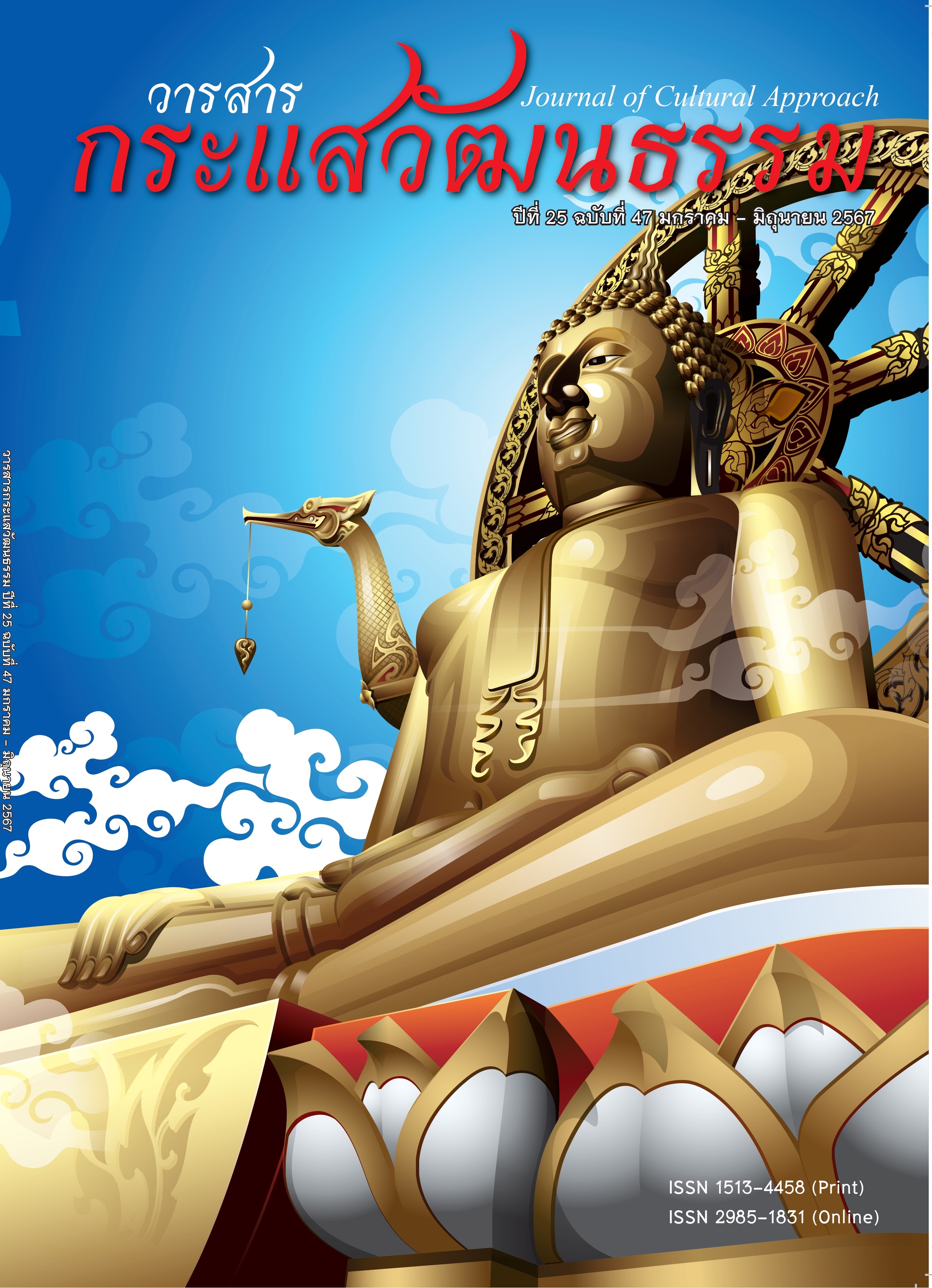Bedroom Decor Product Development Using Woven Fabrics from Local Weaving Community Enterprises in Ban Kha District, Ratchaburi Province, Enhanced with Origami and Embroidery Techniques
Main Article Content
Abstract
The objective of this study was to examine bedroom decoration items made from local weaving fabrics from Ban Kha District, Ratchaburi Province, which employed origami and embroidery techniques. The research involved comprehensive investigations and data collection in order to facilitate the development of products through collaboration with local weaving community enterprises. Within the context of Ban Kha District, Ratchaburi Province, the study encompassed the creation of three distinct types of items: lanterns, pillowcases, and cushion covers. To acquire insights, a combination of expert opinions and data from a sample group was gathered. The data analysis process involved studying a representative population of 100 individuals, with statistical uses such as standard deviation, mean, and percentages being presented in tabular formats.
The analysis results revealed that the lamp design (Type 3), pillow cases (Type 2), and cushion covers (Type 3) were preferred. Respondents expressed satisfaction with the developed bedroom decoration products crafted from woven fabrics sourced from local weaving community enterprises in Ban Kha District, Ratchaburi Province. The incorporation of origami and embroidery techniques further elevated the high satisfaction level, reaching an impressive average rating of 4.19. Upon closer examination, the overall design garnered a commendable average rating of 4.16, while the overall product quality achieved a noteworthy average of 4.20. Notably, the usability aspect garnered the highest average rating of 4.21, underlining the practicality of the products.
Article Details

This work is licensed under a Creative Commons Attribution-NonCommercial-NoDerivatives 4.0 International License.
Proposed Creative Commons Copyright Notices
1. Proposed Policy for Journals That Offer Open Access
Authors who publish with this journal agree to the following terms:
- Authors retain copyright and grant the journal right of first publication with the work simultaneously licensed under a Creative Commons Attribution License that allows others to share the work with an acknowledgement of the work's authorship and initial publication in this journal.
- Authors are able to enter into separate, additional contractual arrangements for the non-exclusive distribution of the journal's published version of the work (e.g., post it to an institutional repository or publish it in a book), with an acknowledgement of its initial publication in this journal.
- Authors are permitted and encouraged to post their work online (e.g., in institutional repositories or on their website) prior to and during the submission process, as it can lead to productive exchanges, as well as earlier and greater citation of published work (See The Effect of Open Access).
Proposed Policy for Journals That Offer Delayed Open Access
Authors who publish with this journal agree to the following terms:
- Authors retain copyright and grant the journal right of first publication, with the work [SPECIFY PERIOD OF TIME] after publication simultaneously licensed under a Creative Commons Attribution License that allows others to share the work with an acknowledgement of the work's authorship and initial publication in this journal.
- Authors are able to enter into separate, additional contractual arrangements for the non-exclusive distribution of the journal's published version of the work (e.g., post it to an institutional repository or publish it in a book), with an acknowledgement of its initial publication in this journal.
- Authors are permitted and encouraged to post their work online (e.g., in institutional repositories or on their website) prior to and during the submission process, as it can lead to productive exchanges, as well as earlier and greater citation of published work (See The Effect of Open Access).
References
Buchaiyaphum, T., Jarujutarat, J. & Kienvong, W. (2022). The Development of Products from Tie-Dye, Case Study: Wat Yai Sri Suphan Community, Hirunruji Sub-district, Thonburi District, Bangkok. Journal of BSRU – Research and Development Institute, 7(1), 206–217.
Kaewpan, T., Itsaranuwat, S. & Plangnok, J. (2020). Principles and Concepts in Product Design. Journal of Humanities and Social Sciences, Surin Rajabhat University, 22(2), 161–182.
Kongjok, A. (2022). Karen Weaving. Ratchaburi.
Maikuntha, S. (2020). The Fascination of the Karen Woven Fabric (Pw Aka Nyaw): Beauty on the Way of Life of the Ethnography. Walailak Abode of Culture Journal, 20(1), 40–48.
Rampungjit, R. & Sorose, A. (2021). Souvenir Product Development of Sukhothai Local Sewing and Craft of Khao Kaew Srisomboon Community Enterprise, Sukhothai Province. Area Based Development Research Journal, 13(4), 268–278.
Thanabuysombati, B. (2018). Origani Phankradas Chladla. Sarakadee Press.
Yaebdi, S. (2015). Development of Household Textiles from Batik Silks: A Case Study of the Motif of Ancient Khmer Art at Sikhoraphum Castle. RMUTP Research Journal, 9(1), 71–79.


